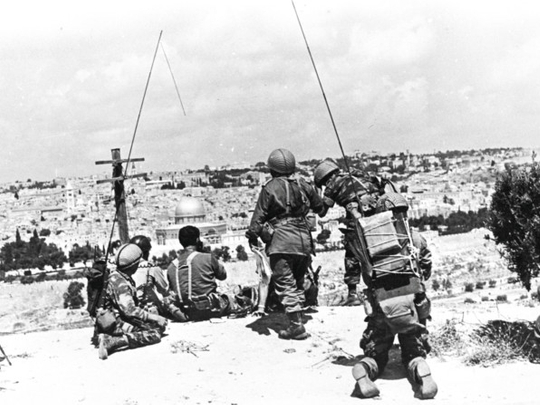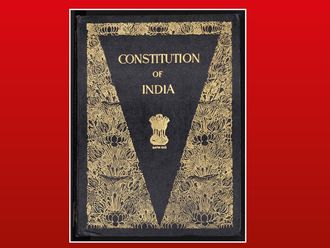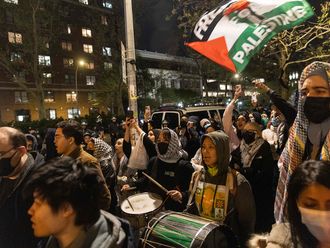
At the 50th anniversary of the June 1967 war, the third Arab-Israeli conflict seems to have had a lasting impact on Arab and regional politics. On the eve of June 5, 1967, Israel launched simultaneous attacks on Egypt, Syria and Jordan, destroying the air forces of the three Arab countries and dominating their airspace. The fallout of the ensuing “Six-Day War”, the results of which came to be known in Arabic as the Naksa, reverberated throughout the Arab region and beyond. It had also implications for military strategies across the globe, given how the military performance of Israel fundamentally altered the nature of warfare and the very way war is waged.
One immediate consequence was that the entire historical territory of Palestine had come under Israeli control, with Israeli forces now in command of the West Bank, including occupied East Jerusalem, as well as the Gaza Strip. Israeli control of the Sinai Peninsula and the Golan Heights put them in command of Egyptian and Syrian territories for the first time, too.
From the early 1950s through to the June 1967 war, the Arab regional landscape was defined by a sharp divide that pitted “Republican” (sometimes called radical) Arab regimes against their traditional or conservative counterparts. This Arab cold war, in fact, occasionally pitted even countries purportedly in the same camp (such as Egypt and Syria) against each other. Israeli provocation during this period intensified in tandem with intra-Arab infighting, reaching a high water-mark with Israel’s efforts to divert water resources flowing down the River Jordan from Syrian territories. By the summer of 1966, aerial sorties had developed into violent dogfights in the skies over the northern Galilee and the Golan Heights, with Israeli air force striking increasingly deeper into Syrian territories against both air force sites and water infrastructure.
Israeli aggression expanded down the river, with its forces flattening all of the houses in the Palestinian town of Samu in the outskirts of Hebron in November 1966. As the pressure was piling on the then Egyptian president Jamal Abdul Nasser to extend protection for the smaller Arab states, he asked an expert group to explore the possibility of withdrawing the United Nations forces stationed on the Sinai Peninsula since the end of the Tripartite Aggression in 1956 so that he could attack should Israel decide to go to war with Syria. Although the group of experts cautioned against such a move, the Egyptian leader did ultimately demand that the international observation force leave Sinai. Nasser’s move, which came on May 15, 1967, was a response not only to Arab pressure but also to information provided by the Soviets, which indicated that the Israelis were amassing their forces on the borders with Syria, where they were purportedly planning a massive military operation. One week after the Egyptian ultimatum, Cairo moved to block Israeli ships from entering the Tiran Straits, providing Israel with the casus belli it needed to attack.
Refugee problem
The official Arab response to the 1967 defeat took the form of an emergency Summit, held in Khartoum on August 29, where Arab heads-of-state adopted their “Three Nos”, insisting that there would be “no reconciliation, no negotiations and no recognition” to the state of Israel. Further afield, the United Kingdom sponsored what became, on November 22, UN Security Council Resolution 242, which spelled out specific demands, including the return of Israeli forces to the armistice lines of June 4, 1967; a “just settlement” of the Palestinian refugee problem; and the preservation of national sovereignty and territorial rights of all states in the region, through the creation of demilitarised zones.
Fifty years after the war, Israeli obduracy on UNSC 242 remained in place. Indeed, Egypt regained its occupied territories following its 1979 peace agreement with Israel, but Palestinian and Syria territories are still under Israeli occupation. Today, nearly half a million Israeli colonists live in the West Bank and occupied East Jerusalem and their number is increasing; making it harder than before for any effort to yield peace between Israel and the Palestinians. Israel is also taking advantage of the Syrian crisis to win international recognition for its unilateral annexation of the Golan Heights.
The administration of United States President Donald Trump may have shown interest in reviving the Palestinian-Israeli peace talks, but it seems to have also condoned the building of colonies in the Occupied Territories and remains silent on Israel’s efforts to seize the Golan Heights. The Trump administration must clarify its position on these fundamental issues before it starts any effort to revive the Middle East peace process. Barring that, it is very likely that we would end having the 100-year anniversary of the June 1967 war, talking about exactly the same issues.
Dr Marwan Kabalan is a Syrian academic and writer.











